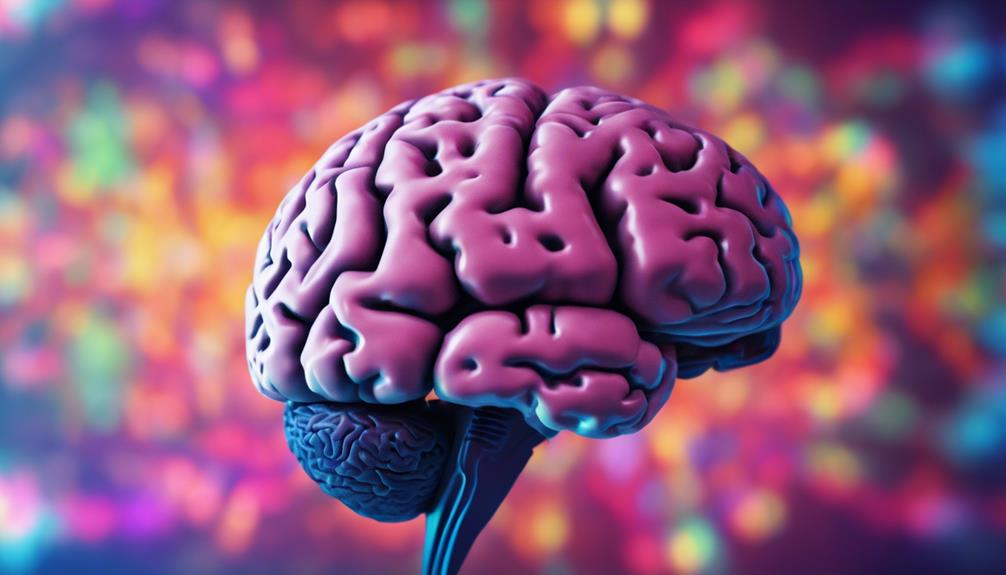
In the domain of pain relief, hypnosis stands as a compelling yet underexplored avenue, offering a unique approach to tapping into the mind's latent abilities. By delving into the intricate interplay between cognition and perception, hypnosis reveals a space where the mind can wield remarkable influence over pain experiences. The potential for harnessing this hidden power lies in the nuanced techniques and strategies that form the bedrock of hypnotic interventions, presenting an intriguing terrain for those seeking an alternative path to managing pain.
The Science Behind Hypnosis for Pain
Have you ever wondered about the scientific basis behind the effectiveness of hypnosis for pain relief?
One key aspect lies in the concept of focused attention. When individuals are under hypnosis, they enter a state of heightened concentration, allowing them to selectively focus on specific suggestions or imagery provided by the hypnotist.
This focused attention can alter brain activity, as demonstrated by MRI images, leading to a reduced perception of pain.
Techniques for Pain Management
When it comes to managing pain through hypnosis, techniques like hypnotic breathing and visualization play an essential role. These methods can offer individuals relief from pain by altering their perception and response to it.
Incorporating hypnotic breathing and visualization into pain management strategies can provide a safe and effective way to address discomfort.
Hypnotic Breathing for Pain
Hypnotic breathing techniques offer a powerful method for managing pain by utilizing slow, deep breaths to induce relaxation and alleviate pain perception. When individuals engage in controlled breathing patterns, they activate the parasympathetic nervous system, promoting a calming effect on the body. This process can help in reducing stress and anxiety, which are often associated with heightened pain levels.
Studies indicate that rhythmic breathing can modulate pain signals in the brain, affecting regions like the anterior cingulate cortex, known for its role in processing pain. By incorporating hypnotic breathing into a regular pain management routine, individuals can experience natural relief from chronic pain conditions.
Additionally, when combined with visualization techniques, the pain-relieving benefits of hypnotic breathing can be further enhanced.
Visualization for Pain Relief
Building on the power of hypnotic breathing, visualization techniques offer a vital approach to pain management by engaging the brain in ways that alleviate pain sensitivity and promote relaxation.
Visualizing activities like swimming can activate the non-dominant brain hemisphere, effectively reducing pain sensitivity. By incorporating selective thinking and visualization, individuals can even undergo pain-free experiences, such as tattoo sessions, using techniques like Dave Elman's anesthesia approach.
Additionally, specialized language styles in hypnosis play an essential role in altering pain perception, particularly evident in children's language development and cases of brain trauma. Understanding the impact of linguistic patterns on pain sensitivity enhances the effectiveness of hypnosis for pain management, as it triggers various brain regions to alleviate pain and induce relaxation.
Leveraging Brain Hemispheres for Relief

Leveraging the distinct capabilities of the brain's hemispheres can greatly impact pain perception and management, offering a promising avenue for relief. Balancing tasks and language functions activate different brain areas, influencing how chronic pain is perceived and managed. By engaging the non-dominant hemisphere through activities like visualizing swimming, individuals can reduce sensitivity to pain. This technique taps into the brain's ability to process sensory information in a way that distracts from or diminishes the experience of pain.
Moreover, utilizing unique language patterns such as baby talk or character voices can induce analgesia by bypassing the conscious critical faculty. These specialized language techniques can be particularly effective in managing chronic pain by shifting the brain's focus away from the perception of discomfort.
In essence, hypnosis effectively leverages the brain's hemispheres to modulate pain perception and provide relief. By understanding and harnessing the brain's hemispheric functions, individuals can enhance their pain management strategies and potentially find significant relief from chronic pain.
Language Patterns in Pain Alleviation
Language plays an important role in pain alleviation through hypnosis. Specific linguistic patterns like baby talk and character voices are used to induce analgesia. The brain's adaptability to various language styles, seen in child language development and brain trauma cases, can greatly impact pain perception.
Understanding and utilizing unique language techniques effectively modulate pain sensitivity. This showcases the intricate relationship between language patterns and pain relief in hypnosis.
Effective Language Patterns
In the domain of pain alleviation, the utilization of unique language patterns has shown remarkable efficacy in inducing analgesia by circumventing the conscious critical faculty. Specialized language styles, such as baby talk or character voices, have been found to effectively bypass cognitive defenses, allowing for enhanced pain management.
Studies on children's language development and cases of brain trauma highlight the brain's adaptability to linguistic changes in pain perception. Hypnosis, leveraging these specialized language patterns, can alter pain sensitivity and improve pain modulation.
Communication for Pain Relief
Effective communication strategies play an essential role in utilizing language patterns for pain alleviation during hypnosis sessions. Special language styles such as baby talk or character voices have been shown to influence pain perception positively.
By understanding linguistic patterns, hypnotists can tailor their communication for pain relief, effectively altering pain sensitivity in individuals. The brain's adaptability to linguistic changes, observed in language development and brain trauma cases, underscores the significance of communication for pain management during hypnosis.
Research indicates that utilizing unique language styles can impact pain processing and perception, as different hemispheres of the brain respond distinctively to linguistic stimuli. Mastering effective communication techniques is vital in harnessing the power of hypnosis for pain relief.
Selective Thinking in Pain Therapy

How can selective thinking in pain therapy enhance individuals' ability to manage and reduce their pain perception effectively?
Selective thinking, a technique utilized in hypnosis, involves focusing on specific areas to decrease the perception of pain. By concentrating on particular thoughts or sensations, individuals can exert control over their pain response, ultimately promoting relaxation and comfort.
Dave Elman's anesthesia technique, for instance, harnesses selective thinking to induce analgesia during hypnosis sessions. This method showcases the power of directing attention to specific elements to alleviate pain.
Additionally, combining visualization with selective thinking has been shown to help individuals achieve pain relief, especially during medical procedures where discomfort may be heightened.
The ability to employ selective thinking as a tool in pain therapy offers individuals a proactive approach to managing their pain experience. Through this practice, individuals can tap into the hidden potential of their minds to modulate their perception of pain and enhance overall well-being.
Hypnosis as a Natural Pain Remedy
Hypnosis serves as a natural and effective remedy for managing and alleviating pain through its ability to modify brain activity and reduce the perception of discomfort. This alternative approach to pain relief has gained recognition from experts like David Spiegel, who has extensively researched the benefits of hypnosis in pain management.
Here are some ways in which hypnosis can be utilized as a natural pain remedy:
- Altering Brain Activity: Hypnosis has been shown in MRI images to alter brain activity, leading to a reduction in the perception of pain.
- Utilizing Pacing and Leading Techniques: Inspired by Milton Erickson, these techniques are effective in pain removal through hypnosis.
- Safe Alternative to Traditional Methods: Hypnosis offers a safe alternative to conventional pain relief methods such as anesthesia and opioids, with advocates like Julie Sulter and Benjamin Ryan supporting its use.
- Engaging Non-Dominant Brain Hemisphere: Visualizing activities like swimming can engage the non-dominant hemisphere of the brain, effectively reducing pain sensitivity.
Through these methods, hypnosis provides a natural and holistic approach to pain relief.
Benefits of Hypnosis in Pain Relief

With its proven ability to alter brain activity and reduce pain perception, hypnosis emerges as a valuable and safe method for managing and alleviating discomfort. MRI images have shown that hypnosis effectively changes brain activity to decrease the perception of pain. This non-invasive approach to pain management provides a safer alternative compared to the risks associated with anesthesia and opioids.
Techniques such as pacing and leading, inspired by Milton Erickson, have demonstrated success in removing or reducing pain using the power of hypnosis. By engaging both hemispheres of the brain, hypnosis can modulate pain sensitivity, offering a unique and holistic approach to pain relief. Through visualization techniques and specific language patterns, hypnosis can activate different areas of the brain, enhancing outcomes in pain management.
The power of hypnosis lies in its ability to tap into the brain's resources to alleviate suffering, making it an increasingly recognized method for addressing various types of pain.
Frequently Asked Questions
Can You Get Hypnotized for Pain Relief?
Yes, individuals can benefit from self-hypnosis techniques for pain relief. By harnessing the power of their mind, individuals can induce a state of relaxation and focus that aids in managing pain perception.
Self-hypnosis techniques involve deep breathing, imagery, and positive affirmations to promote a sense of well-being and reduce discomfort. Through regular practice and guidance, individuals can empower themselves to alleviate pain and enhance their overall quality of life.
Can Hypnosis Alter Perception of Pain?
Hypnosis has demonstrated significant effectiveness in altering the perception of pain. By leveraging techniques like pacing and leading, hypnosis can induce analgesia by influencing brain activity.
This safe and alternative approach to traditional pain management methods like anesthesia and opioids offers individuals a means to reduce pain sensitivity.
Through visualization and unique language patterns, hypnosis showcases its potential in reshaping how individuals perceive and experience pain.
What Kinds of Pain Has Hypnosis Effective Diminished?
Hypnosis has proven effective in alleviating various types of pain, including chronic migraines. This therapeutic approach has shown promising results in managing persistent pain conditions by altering brain activity and perception.
Through techniques like selective thinking and visualization, individuals have experienced relief from debilitating pain, enhancing their quality of life.
The use of hypnosis in pain management continues to garner recognition for its ability to provide significant relief in various medical contexts.
What Is Gate Control Theory of Pain Hypnosis?
The Gate Control Theory of Pain proposes that hypnosis can influence pain perception by regulating the transmission of pain signals in the spinal cord. Hypnosis techniques leverage cognitive and emotional processes to modulate the intensity and discomfort associated with pain.
Conclusion
To sum up, hypnosis offers a powerful and often overlooked tool for pain relief. By tapping into the hidden potential of the mind through focused attention, visualization, and language patterns, hypnosis can effectively reduce the perception of pain and enhance pain management outcomes.
Just as a skilled conductor brings harmony to a symphony, hypnosis can orchestrate the brain's activity to alleviate pain and promote well-being. Embracing hypnosis as a natural pain remedy can reveal transformative healing possibilities.




